Can I tell you something embarrassing?
A few summers ago, I was at a lake with my fiancé (and her entire extended family) when someone suggested we go kayaking. I tip-toed into the rented kayak when WHAM! I fell flat on my face.
Okay, so my balance isn’t the best. But that’s okay because I found a secret weapon that helps me look pretty cool in front of my friends, family, and, yes, even my in-laws.
May I present the mighty kayak outrigger, which are floaties that attach to your yak for greater stability. While many people use outriggers for kayak fishing, they’re also great for novice paddlers while you get the hang of riding in a kayak.
But before you toss outriggers in your Amazon cart, let’s discuss the pros and cons of some popular stabilizer materials, their durability, as well as the best kayak outriggers on the market.
Product
Details
The Versatile

Hobie Sidekick Ama Kit
- Weight: 5 pounds
- Material: Vinyl
The Speedy One
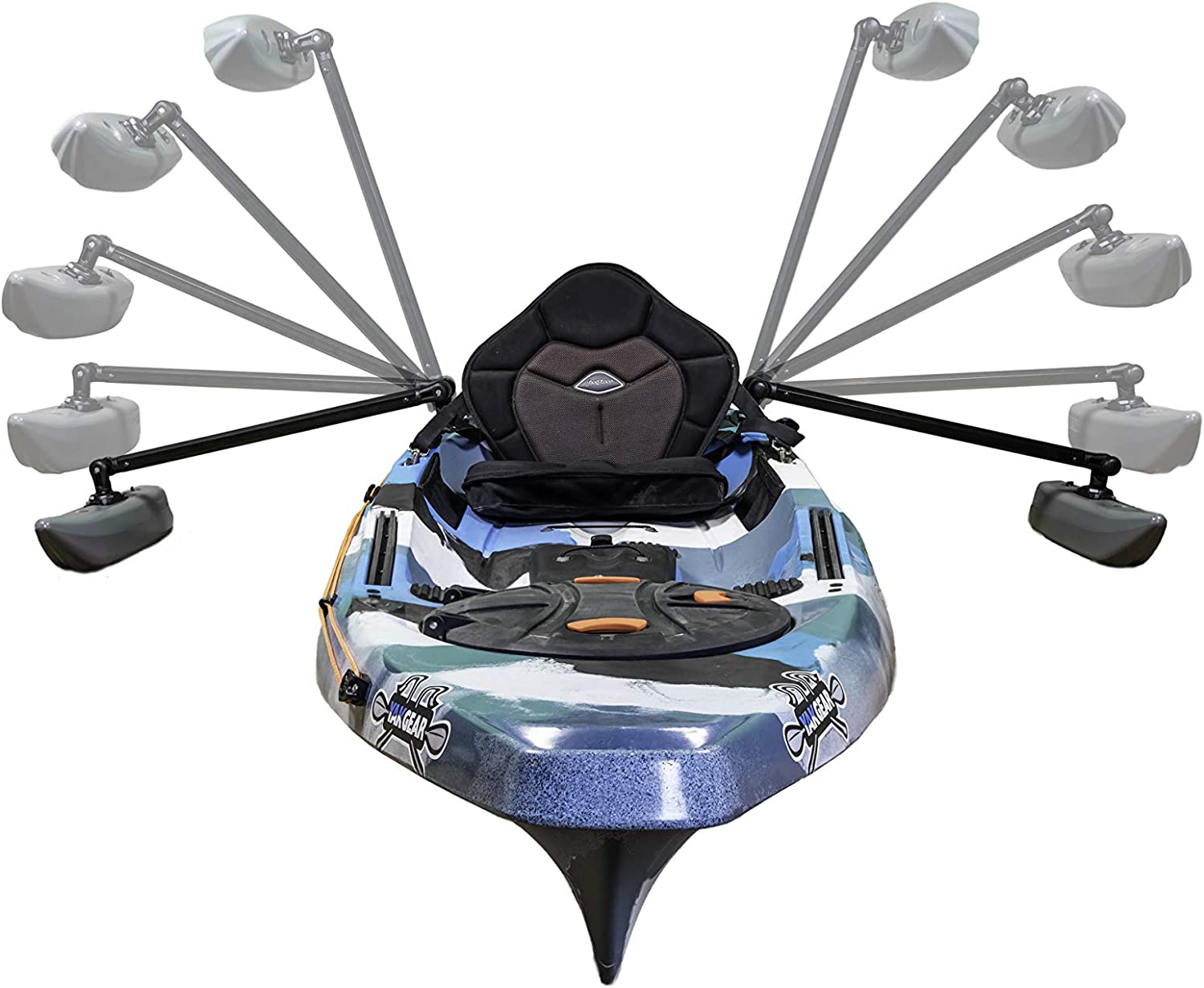
YakGear Kayak
- Weight: 6.8 pounds
- Material: Aluminum and Plastic
Stable and Reliable
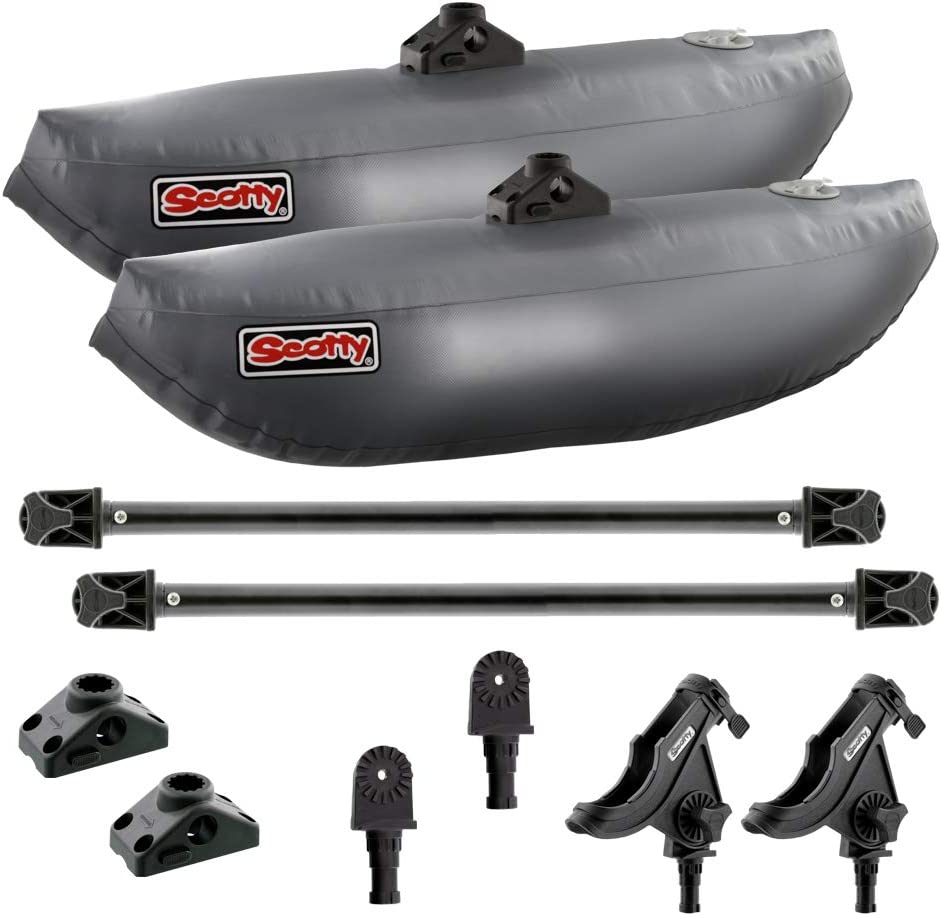
Scotty #302
- Weight: 10 Pounds
- Material: Synthetic Floaties
Budget-Friendly Option
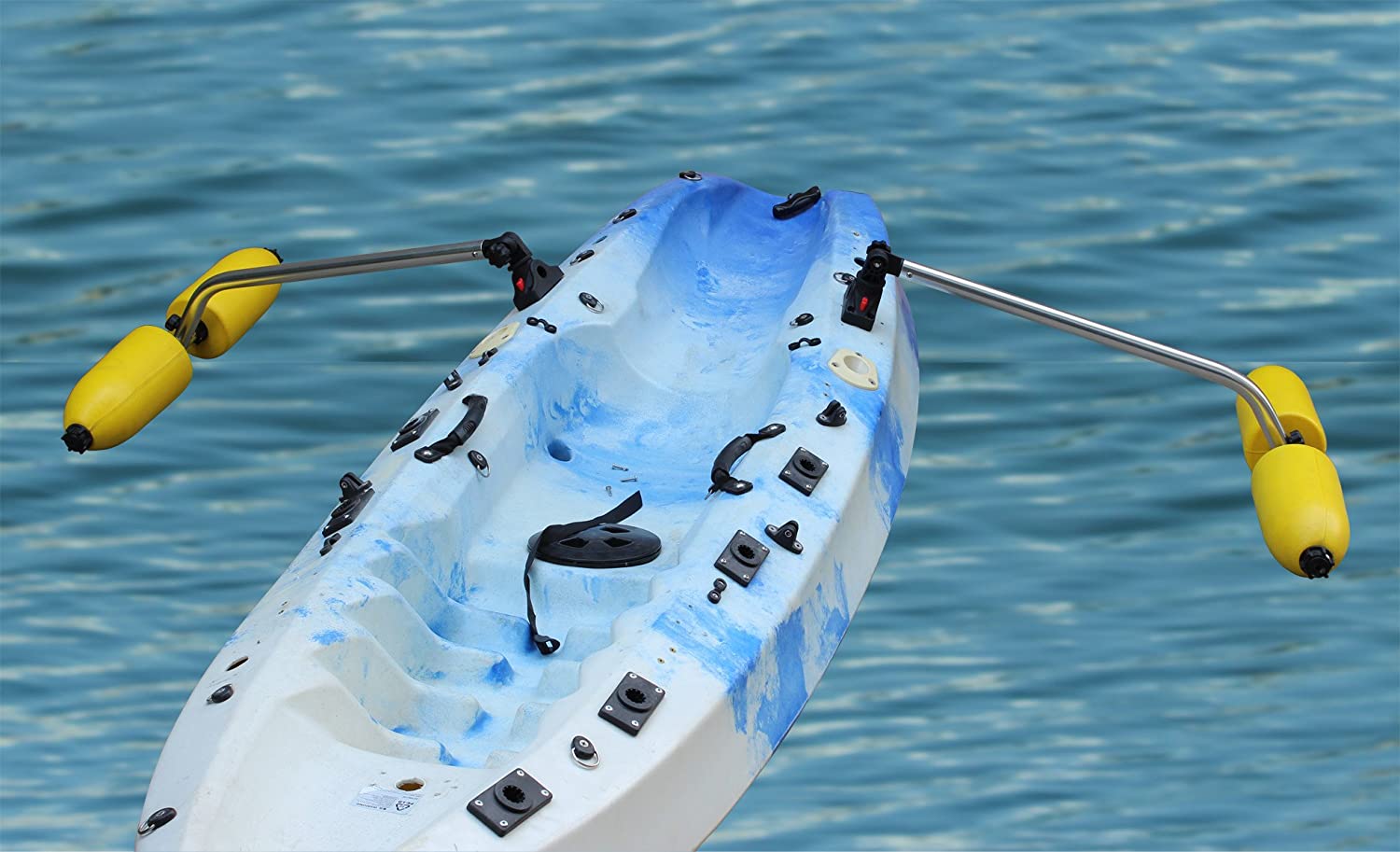
Brocraft Kayak
- Weight: Roughly 9 pounds
- Material: Stainless Steel, PVC
Fast Installation
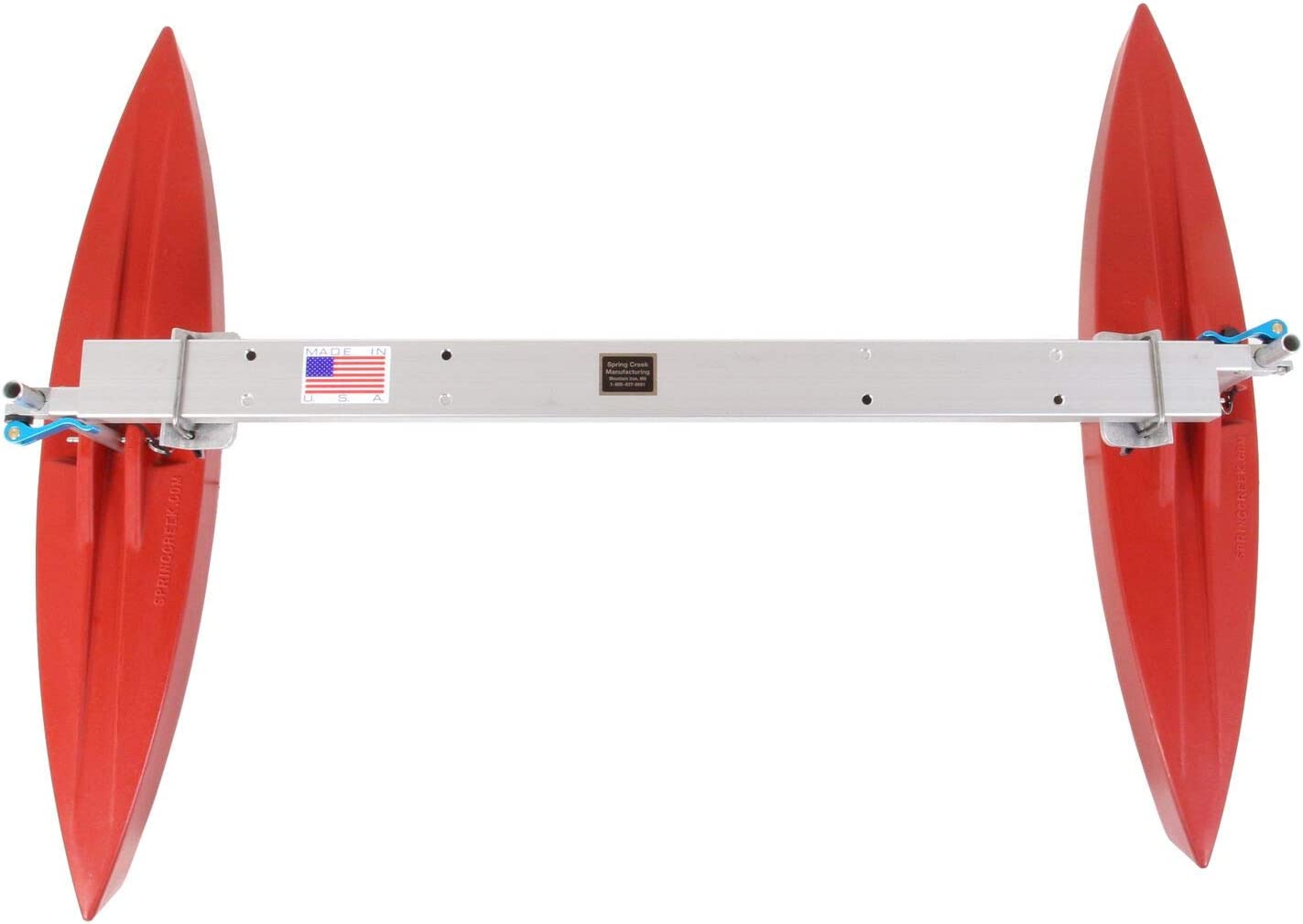
Spring Creek
- Weight: Roughly 13 pounds
- Material: Polyethylene plastic
High-Quality
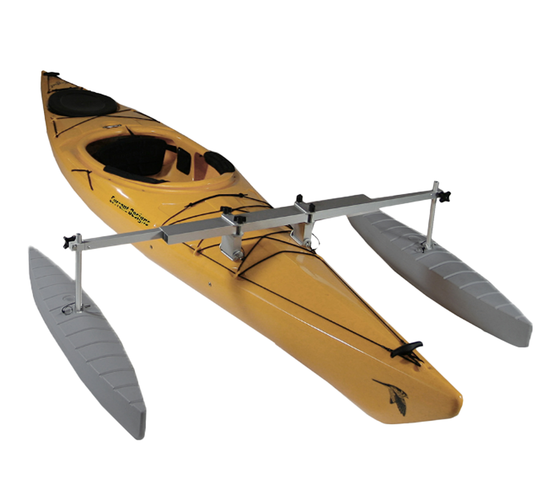
Wave Armor KAYAK
- Weight: 20 pounds
- Material: Polyethylene floats
Our Top Picks for Best Kayak Outriggers
Below are a few of the best kayak outriggers and stabilizers that are tried and tested, making your choice easier.
1. Hobie Sidekick Ama Kit
Though they’re light, these impressive Hobie inflatable outriggers provide unwavering stability for yakers on calm waters and paddlers punching through hostile waves.
The Hobie Sidekick AMA kit is versatile; it comes with three different levels, so you can customize the levels to exactly where you want.
To adjust, simply twist and click to the desired float height. This way, you can enjoy the floats above the waves as you speed through the water or rest the float down when you need the best kayak anchor and stability.
To be honest, the Hobie sidekick AMA kit comes with a big price tag. However, the quality of the stabilizer system is well worth the money if you’re prepared to make a long-term investment.

Do they make me a little nervous because they only use vinyl? Yes. Would they probably be heartier with a nylon outer layer? Definitely yes. Still, I haven’t heard of these popping or deflating for any paddler, so maybe Hobie deserves more credit than I’m giving them.
Ultimately, the Hobie Sidekick is a good fit for nearly any kayak.
Features
- Weight: 5 pounds
- Material: Vinyl
- Type: Inflatable
Pros
- Though outriggers are notorious for slowing down speeds, Hobie eliminates this problem with the adjustable levels that keep outriggers out of water during paddling.
- Screwing in these kayak stabilizer systems is an easy process that only requires twisting and clicking.
- Hobie includes a patching kit in their models should your inflatables sustain injuries.
Cons
- The outrigger floats could be built with more rugged materials for better peace of mind.

Hobie Sidekick Ama Kit
The Price of “Hobie Sidekick Ama Kit” varies, so check the latest price at
2. YakGear Kayak
There’s no shortage of reasons to dig the speedy, easily storable YakGear Kayak Canoe Outriggers. Personally, I like these because the floaties rise above the seat, making moments like pulling into a dock much, much easier.
Inflatables rising from the seat also bring other perks, like how drag is cut to a minimum.
Additionally, the outriggers are easy to remove, making the packing-up operation seamless once the day is over. After all, nothing is worse than wrestling with screws and clamps after a long day under the sun.
The main drawback here is the time-consuming installation process. Not only does it take a fair amount of elbow grease to install, but the notches can be too high or low (depending on your kayak), which can be more than a little frustrating.
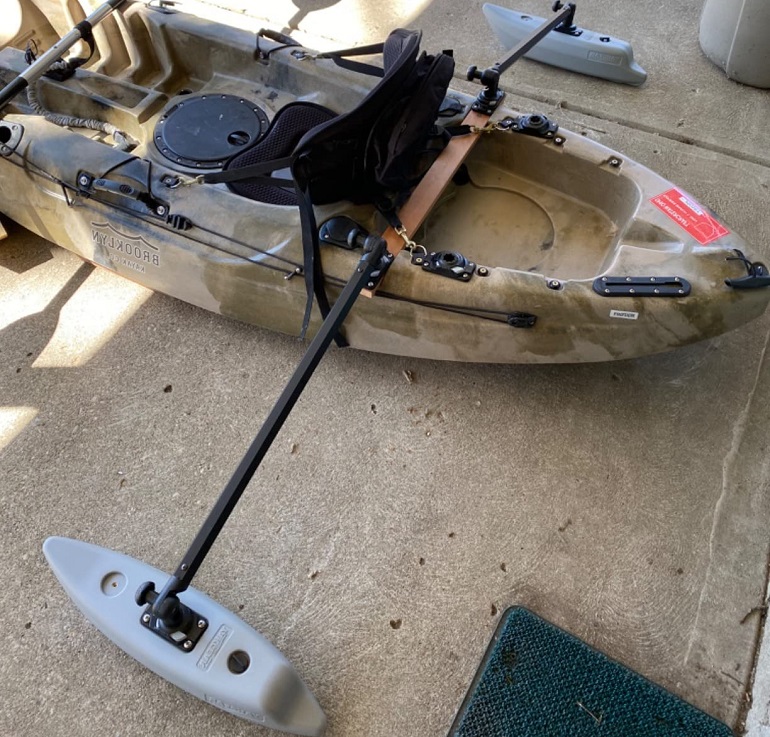
Additionally, the floats aren’t stable enough to stand for long periods, especially in choppy water. As a result, I would avoid using these for fishing kayaks; instead, use the YakGear outriggers for boosted stability while learning how to kayak.
Features
- Weight: 6.8 pounds
- Material: Aluminum and Plastic
- Type: Inflatable
Pros
- These kayak outriggers provide minimal drag, which is excellent for those paddling long distances.
- YakGear outriggers are easy to remove, making storage and transport a breeze.
- The floaties are adjustable during transit, which helps to navigate tight corners or pull up to the dock.
Cons
- There’s no way to slice it: these kayak outriggers have finicky hardware, which makes it challenging to install.

YakGear Kayak
The Price of “YakGear Kayak & Canoe Outriggers ” varies, so check the latest price at
3. Scotty #302
Say goodbye to kayak tipping and hello to an incredibly stable outrigger system for kayaks with the Scotty Kayak Stabilizer System.
This kayak stabilizer system utilizes heavy-duty PVC plastics to bloat two inflatable pontoons for trustworthy steadiness for the avid kayaker. Meanwhile, aluminum outrigger arms extend these bladders far out in choppy waters to be as out of the way as possible.
Durable, lightweight anodized aluminum arms use four locking deck mounts for a proper, trustworthy installation system. What’s more? Its molded PVC floats seem to be immune to jagged rocks and rough water.
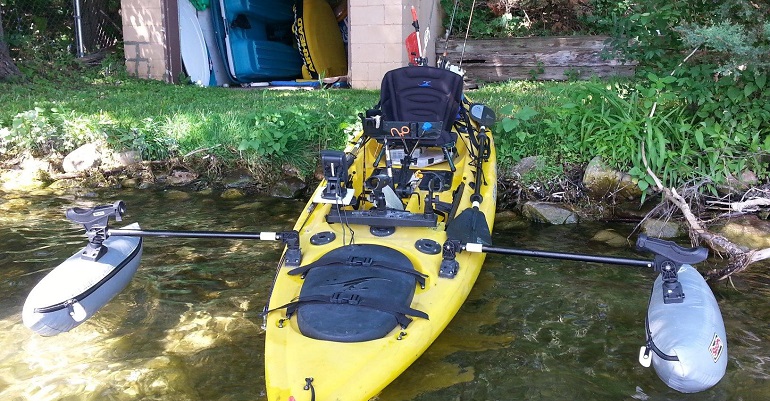
From fly fishing to diving to photography, these inflatables transform any rocky canoe or kayak into a sturdy vessel. It also comes with fishing rod holders for the anglers among us. As a result, it’s terrific for catching fish.
The Scotty outriggers are also highly adjustable. Unfortunately, though, the act of adjusting is a big pain as it requires you to unscrew a very tight knob. If you’re looking for speed, look the other way. While the Scotty inflatables greatly increase stability, they also greatly increase drag.
Mostly this is due to their shorter length. Additionally, its anodized aluminum arms don’t stand up to salt water very well; make sure you only use this outrigger stabilizer in freshwater.
Features
- Weight: 10 Pounds
- Material: Synthetic Floaties/Anodized Aluminum Stabilizer Arms
- Type: Inflatable
Pros
- Its stability makes it great for catching fish
- Mounting outriggers is easy with their hardware.
Cons
- This Scotty Kayak stabilizer system is far shorter than other kayak pontoons, and its small length drastically increases drag and reduces speed.
4. Brocraft Kayak Outriggers
Sharp rocks and choppy waters are no match for the Brocraft Kayak Outrigger system. The inflatables are made with puncture-resistant plastics, steel, and PVC for a blend that can stand up to any obstacles on the water.
Speaking of steel, the stainless steel mounting system makes for an outrigger system that’s equally stylish as it is effective. Then, its wide wingspan juts far out into the water, which means it won’t impede your paddling
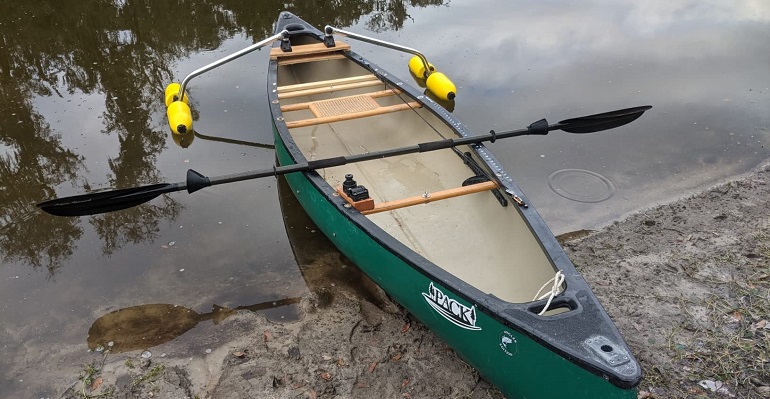
Without a doubt, the most challenging aspect of the Brocraft stabilizer system is its installation process. Occasionally, the adjustments do require alterations. In the past, kayakers have had to design special mounts above their kayak or canoe to ensure the outriggers were floating on the water.
While these certainly do their intended job, you may have to play around with heights and alterations to ensure the two outrigger arms are effective.
Still, at an affordable price, these are good starter outriggers (especially if you have a starter kayak).
Features
- Weight: Roughly 9 pounds
- Material: Stainless Steel, PVC
- Type: Hardshell Kayak Outriggers
Pros
- These outrigger floats are some of the most affordable on the market.
- Brocraft outrigger system has a wide wingspan to not impede paddling.
- The steel and PVC outrigger floats are durable and robust.
Cons
- Adding outriggers takes time to get the adjustments right.

Brocraft Kayak Outriggers
The Price of “Brocraft Kayak Outriggers” varies, so check the latest price at
5. Spring Creek Manufacturing
Forget about inflatable bladders or a maddening installation process. The Spring Creek Hydrodynamic uses easy, intuitive clamps to secure the lightweight Polyethylene plastic floats on your kayak and canoe.
Most outriggers come in three positions, but Spring Creek Manufacturing surpasses the status quo with its four-size system (30″, 36″, 40″ and 45″). This way, no matter what size kayak or canoe you have, the Hydrodynamic outrigger set can fit your needs.
The floaties’ hydrodynamic design gives you the best of both worlds: speed and stability. Somehow, Spring Creek’s hardshell outriggers don’t compromise drag even though the sturdiness is nearly unparalleled
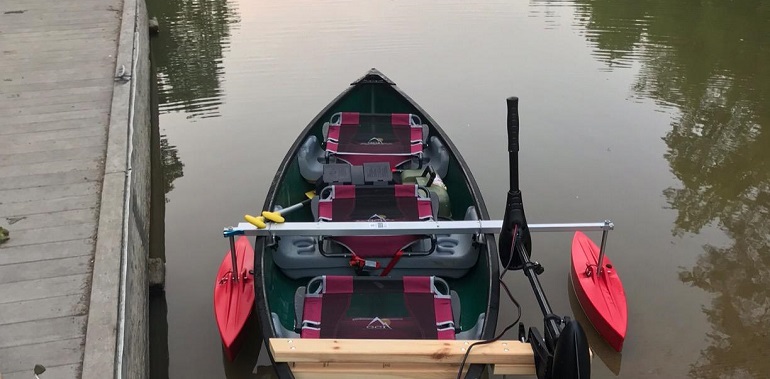
Spring Creek is onto something: simple is best. The minimalist design with easy adjusting and mounting hardware eliminates headaches. This way, you won’t need to drill holes in your kayak and can spend more time on the water.
As easy as it may be to adjust the floaties, you cannot do so while in the vessel. This makes for quite the production if you attempt to adjust mid-route.
And, occasionally, users have some issues with durability; I’ve had one friend complain that the support system showed wear and tear after only a couple of weeks on the water.
Features
- Weight: Roughly 13 pounds
- Material: Polyethylene plastic, steel
- Type: Hardshell
Pros
- The minimalist mounting hardware makes installation easy.
- Their four settings make this set one of the best kayak stabilizers for personalization.
Cons
- The durability and wear can be an issue with the arms and stabilizers.

Spring Creek Manufacturing Hydrodynamic
The Price of “Spring Creek Manufacturing Hydrodynamic” varies, so check the latest price at
6. Wave Armor KAYAK
There’s a cloud of mystique around Wave Armor’s stabilizer; these kayak outriggers are not widely used, so there’s a lot of chatter – both on the Internet and among the kayak community on whether or not these outriggers are worth it.

Allow me to shed light on the subject. Wave Armor produces an admirable product. For one, the hydrodynamic design improves the kayak’s stability without compromising speed or agility
And if you’re worried about sustaining injuries mid-journey, don’t be. Wave Armor hearty Polyethylene Floats fight back against obstacles.
Furthermore, the stabilizer kit utilizes a vibrant blend of anodized aluminum and stainless steel to keep parts lasting for years of use – so long as you only clamp it on before trekking out into fresh water.
Features
- Weight: 20 pounds
- Material: Polyethylene floats, Anodized aluminum, and stainless steel parts
- Type: Hardshell
Pros
- Constructed with high-quality products.
- Paddlers can adjust the polyethylene floats in multiple ways for ease of use.
- These kayak pontoons use stainless steel mounting hardware for a clean, sophisticated look.
Cons
- Aluminum stainless steel hardware isn’t good to use in saltwater over long periods.

Wave Armor KAYAK
The Price of “Wave Armor KAYAK” varies, so check the latest price at
Buying Guide for Best Kayak Outriggers
Buying kayak outriggers the first time is a game changer.
Kayak outrigger and stabilizer transform a wobbly vessel into a steady platform you can confidently use for nature photography, novice paddling, or to transform your kayak into a fishing pontoon.
But that doesn’t mean every kayak outrigger is the right pick for you and your needs. There is a surplus of options to pursue when shopping for kayak pontoons, and even if one of them boasts good reviews, you may need something completely different.
Let’s explore more about what makes a good kayak outrigger – and what you should look for in your next kayak stabilizer system.
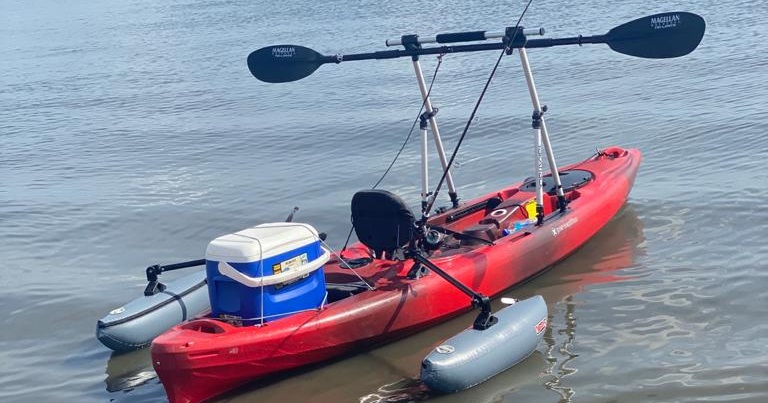
Types of Kayak Stabilizers
The two main types of outriggers are solid kayak outriggers and inflatable outriggers. Solid outriggers are typically made with PVC and add much more weight to your kayak (so bear that in mind when you’re tempted to pack more gear than you actually need on your next excursion).
Solid outriggers are also harder to transport and store. Consider the difference between tossing up chunks of hard, wet plastic on your roof versus deflating plastic and tucking it in your trunk.
As you might imagine, the biggest perk of inflatable stabilizers is that they leave you with plenty more space when it comes time to store and transport the outrigger. Additionally, solid outriggers cost less than inflatables.
But on the other hand, inflatables are much more likely to tear or rip during kayak adventures.
If you choose to go with an inflatable outrigger, make sure it comes with a pump. Blowing up some giant inflatables by mouth will leave you so dizzy you’ll see stars — and not the kind that grants any wishes.
Transportability
No matter how you see it, if you can’t quickly get your stabilizers off your kayak for easy transport back home, you’ll become very frustrated with your new purchase.
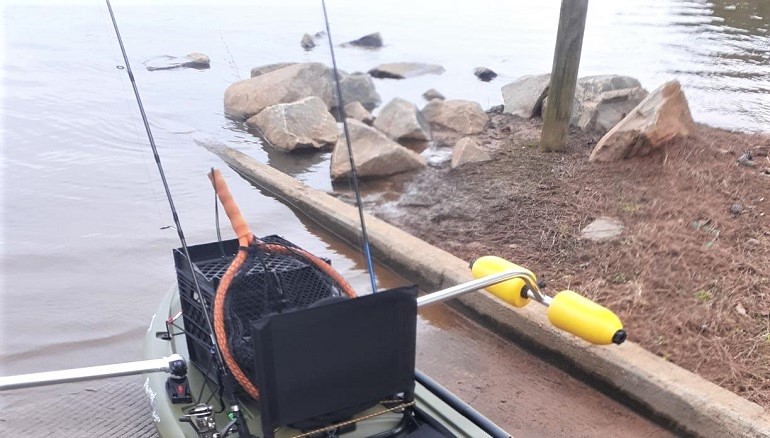
Some outriggers are attached so firmly onto the edge of the kayak that it can feel like you’re sumo wrestling just to get them off. Moments like these are when inflatables come in handy.
For this reason, it’s a good idea to go into a store like REI or Sporting Goods to see the model in person. This way, you can see if they are easy to remove and transport before you dish out your cash.
Material
Back in the day, most kayak outriggers used polished and anodized aluminum for the outrigger arms. And it’s easy to see why there was so much hype.
Lightweight and boasting a durable finish, aluminum is the perfect outrigger material. That is until time passed, and we found one fatal flaw: as aluminum is stretched further and further out on the water, it isn’t strong enough to hold up to all the added stress.
That’s right: once your outrigger surpasses 18 feet of pole length, aluminum can start to crack and break from too much stress.
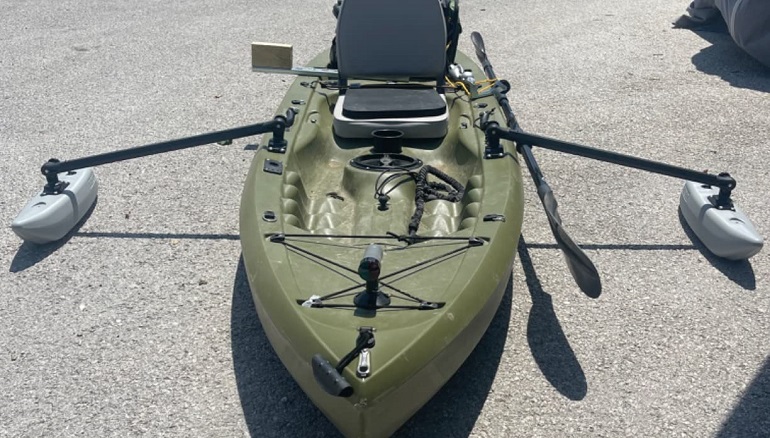
Nowadays, a lot of high-end outrigger arms are made with carbon fiber. Strong and rigid, carbon fiber is a profoundly durable material that doesn’t weigh that much. As a result, paddlers can use these arms for longer distances without feeling the strain as much as aluminum.
But what about the outrigger itself? What sort of material should you look for? For a hardshell plastic outrigger, it’s best to purchase rotomolded polyethylene plastic or PVC outriggers, as they use hearty materials. If buying inflatables, go for ones that have a thick exterior membrane with welded seams.
Lastly, when choosing the arm and floatation material for your kayak stabilizer, be aware of what materials corrode with salt water. For example, aluminum degrades quickly in saltwater. If you’re hitting the Atlantic or Pacific, plastics are the way to go.
Hydrodynamics
Don’t be intimidated by this fancy word. Hydrodynamics refers to the forces exerted on bodies of water; I’m talking about how well your outriggers do on the water. Do the outriggers slow down the kayak or canoe? Or is its drag minimal and barely felt?
Obviously, less drag is better for kayak or canoe outriggers. However, some paddlers might value other features like more stability and be willing to sacrifice more drag.

Here’s the deal; the longer the outriggers are, the less drag they create. That’s why you’ll always see long kayak stabilizers or long inflatable pontoons on the end of racing boats.
Consider what you need the outriggers for, and then consider if you’ll be bothered by a slower kayak.
Weight
Weight capacity is vital to consider when shopping for new kayak stabilizer systems. It’s critical to purchase a kayak stabilizer kit to fully support your kayak and all the weight you plan to bring.
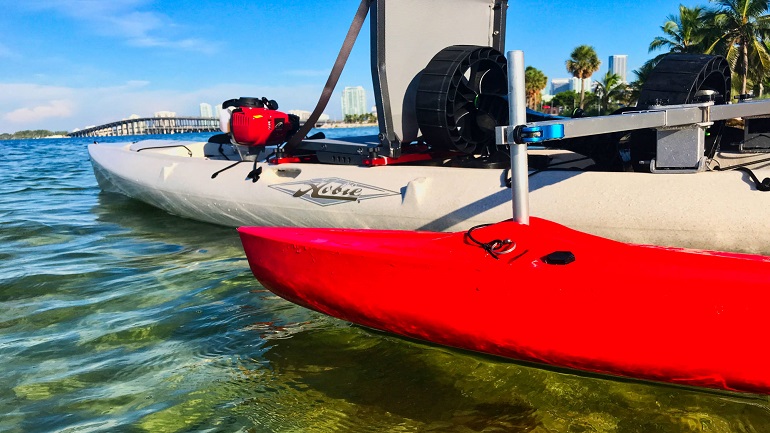
Why? If you, your kayak, and all your gear are too heavy, they’ll sink underwater and be rendered useless. Or, worse, you’ll capsize your entire kayak!
Moveable vs. Fixed Stabilizers
There are two types of mounting stabilizers: moveable stabilizers and fixed.
Some kayakers choose a fixed outrigger when they want to be very precise about where to place the outrigger. As the name suggests, this stabilizer will not move (unless you re-mount the entire system) for accurate placement.
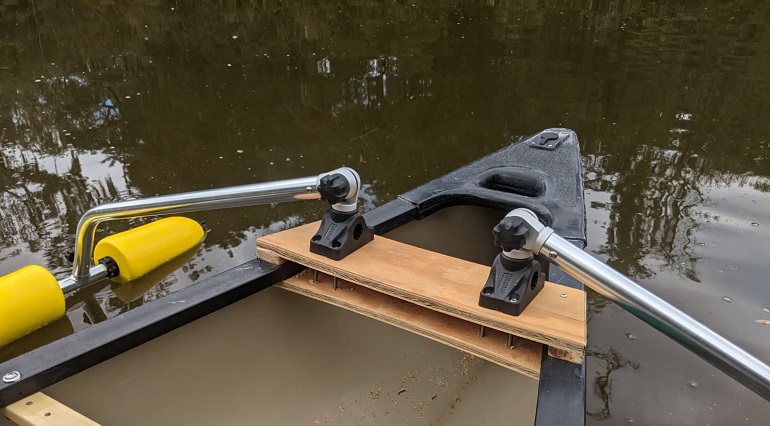
On the other hand, a moveable stabilizer is excellent for on-the-fly adjustments mid-trek. You may get out on the water and realize it’s much more comfortable or practical to place the outriggers higher, lower, further, or behind.
Durability
The key to the best inflatable floats or hard shells is to find one that will last: not one that looks flashy for a few joy rides around the lake. But with so many pieces that make up outriggers, durability affects many aspects of the buying process.
For example, you must be mindful of how outrigger arms can corrode in saltwater. Should you plan to kayak in the ocean, steer clear of metals and steel and instead opt for plastic.
If you choose an inflatable shell, you’ll want to make sure you’re buying quality inflatables with welded seams and strong plastics to ensure the floaties won’t tear the moment you launch off the beach.
FAQs
Questions? Confusion? Fear not, dear paddler; I’m here to help! Below are the answers to some of the most frequently asked questions regarding how to choose the best kayak outriggers.
Should I Put Outriggers on My Kayak?
Honestly, the answer depends on your skill level, balance abilities, and how you plan to use your kayak.
Look at it this way: if you’re using your kayak for fishing, add a stabilizer since you’ll be standing up for long periods. If your balance is a little weaker, outriggers can help you get the hang of the sport.
The downside? Adding paddling outriggers will make your kayak look a little…goofy. It’s an immediate tell that you’re a novice kayaker who needs some extra buoyancy and assistance on the water
But don’t let looks steer you away from using a flotation device! If you need extra stability for fishing, photos, or practice, you should absolutely install extendable arms and stabilizer systems.
How Long Should Kayak Outriggers Be?
Generally, mounted kayak outriggers should be between 30 and 36 inches long. You should attach them directly behind the seat and position them roughly three-quarters of the way toward the stern of your kayak.
Can You Stand in a Kayak With Outriggers?
Yes! You can absolutely stand in a kayak with outriggers. In fact, using a kayaking stabilizer to stand on your boat is one of an outrigger’s main uses. Because of this, kayak anglers may be interested in purchasing mounted outriggers as they are great for fishing.
That’s a Wrap!
Long story short on the best kayak outriggers? Stabilizers can be your best friend if you’re hunting for more steadiness on recreational kayaks. With the proper hardware and quality mounting arms, you can transform your rocky, choppy vessel into a sturdy boat to practice kayaking on or to fish on.
Now, for all you kayakers out there, get offline, grab your yak, and sail into the sunset.
0 Comments